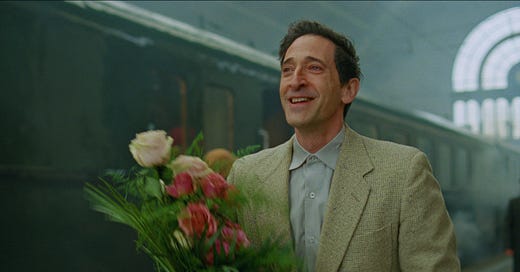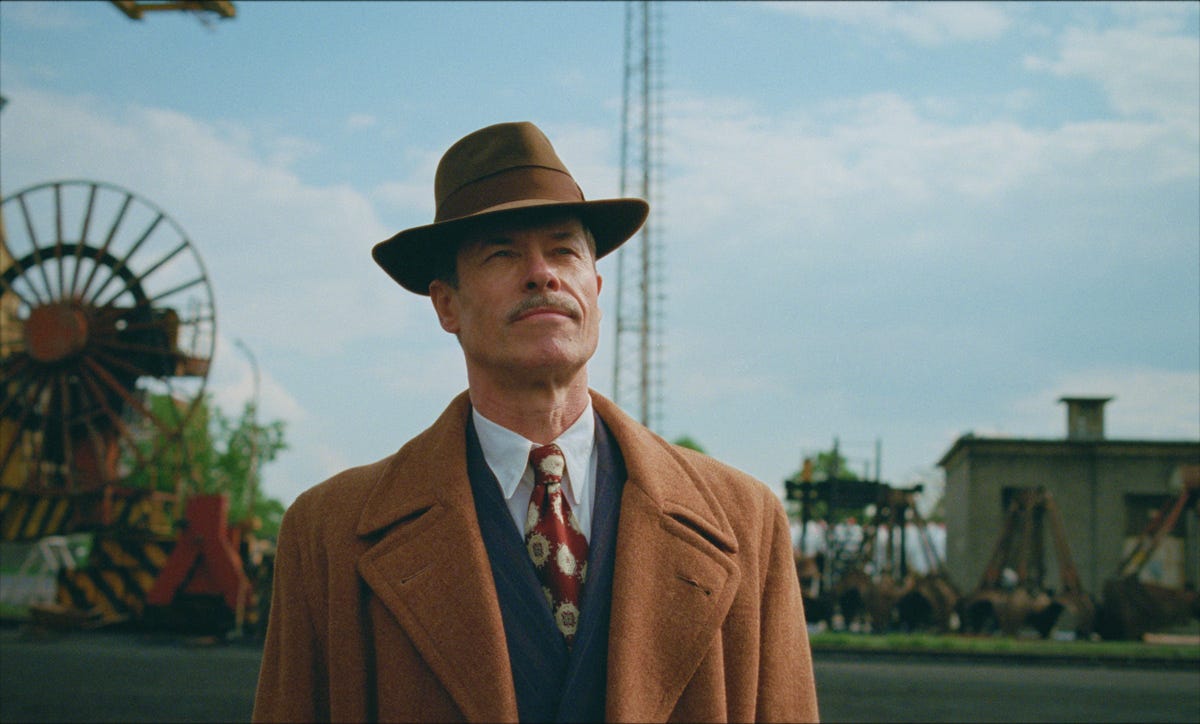'The Brutalist' is a Majestic, Confounding Epic
"It feels like they spent more time on the intermission graphic than on wrapping up a three-and-a-half-hour movie."
Welcome to The #Content Report, a newsletter by Vince Mancini. I’ve been writing about movies, culture, and food since I started FilmDrunk in 2007. Now I’m delivering it straight to you, with none of the autoplay videos, takeover ads, or chumboxes of the ad-ruined internet. Support my work and help me bring back the cool internet by subscribing, sharing, commenting, and keeping it real.
—
I still hadn’t seen The Brutalist up until this week, even after it was appearing on countless best-of-2024 lists and beginning to become the now-odds-on-favorite to win Best Picture at the Oscars. This was due to various factors, but mostly the obvious one: the movie is three hours and 36 minutes long. At long last, I managed to correct this oversight this past week.
There are many things to love about The Brutalist, like that it’s gorgeous to look at and seldom drags, even at the bloated run time. It’s also an unabashed epic, designed specifically for the theatrical experience (shot in VistaVision! it includes an intermission!) in an era when we don’t get many of those. I left the theater feeling like didn’t entirely “get” it, but I can even put a positive spin on that.
Great art should be confounding in some way, irreducible to a pat message. As long as it’s not faux-confounding as a deflectionary tactic, which a lot of arthouse and festival movies unfortunately are. But The Brutalist isn’t opaque in a tastefully-say-nothing kind of way, and if anything is defined more by an abundance of bold artistic choices than by their lack. Above all, The Brutalist is defiantly weird. Not always in a smart way, but sometimes weirdness is enough.
Adrien Brody plays Laszlo Toth, a fictional Hungarian-Jewish architect who has been separated from his wife during the Holocaust. In the film’s first chapter, “The Enigma of Arrival,” Toth arrives at Ellis Island in 1947, only finding out that his wife is still alive (but still in Europe) from his cousin Attila (the vastly underrated Alessandro Nivola) when he steps off the bus in Philadelphia.
The Brutalist is the third directorial effort from Brady Corbet, co-written with his partner Mona Fastvold, who together have come to occupy a peculiar niche in the world of cinema: they makes movies that profile fictional subjects in ways that function so convincingly as biopics that search queries like “Is Laszlo Toth real?” inevitably spike in their wake. 2015’s The Childhood of a Leader chronicles the childhood of a future fascist leader in the interwar period. Vox Lux (2017) is a futuristic portrait of a pop star played by Natalie Portman, who initially rises to fame as an eighth grader who befriends a school shooter.
There’s something irresistible about movies that ape the epic bio format without being beholden to song rights or a celebrity’s memoir or estate, let alone historical facts. In a way, a movie about Laszlo Toth can be more real if he’s not a real person.
Struggling to settle into life in Philadelphia, Laszlo goes to work designing furniture at Attila’s store. Things soon get weird between Laszlo, his desperate-to-assimilate cousin (who has changed his last name to “Miller”), and his cousin’s Catholic wife, Audrey (Emma Laird). Audrey makes unsubtle suggestions that Laszlo should find somewhere else to live, and Attila at first seems to goad Laszlo into a throuple (c’mon, cuz, stop being a pussy and fuck my wife). Yet Attila soon accuses Laszlo of makin’ a pass at her, Raging Bull-style, and the two fall out — thus establishing what will become The Brutalist’s two main themes: barely disguised anti-Semitism and weird sexual stuff. It’s honestly an achievement what The Brutalist does just with that.
A few other things happen before Laszlo sets off on his own: he strikes up a heroin addiction (at first to treat untreated injuries from captivity) and gets involved with an imperious benefactor: Harrison Van Buren Sr., a grandstanding war profiteer and inveterate bully played by Guy Pearce, who should’ve gotten a separate Supporting Actor nomination for his mustache alone. After initially stiffing him on a renovation job, Van Buren plucks Laszlo off of a job shoveling coal, discovers that he was actually a once-acclaimed architect who studied at Bauhaus and hand picks him to design a massive community center project as a tribute to Van Buren’s departed mother.
Van Buren invites Laszlo to live on the Van Buren estate, much to the chagrin of Van Buren’s overgrown Biff-esque failson, Harrison Jr. (Joe Alwyn), and the failson’s outwardly nice, inwardly shitty Ivanka twin (Stacy Martin). Eventually Van Buren pulls strings to get Laszlo’s wife, Erzsébet (Felicity Jones) and mute niece, Zsófia (Raffey Cassidy) brought over from the old country, and all the Toths soon get the unmistakable feeling that they’re not really wanted there. And yet, Laszlo remains too obsessed with the opportunity to build his Brutalist masterpiece to ever quite escape the Van Buren thumb, even as he clashes with the Van Buren kids, frugal contractors, and rival architects.
It’s actually eerie how much of The Brutalist plays like a Jackie Jormp-Jomp version of Ayn Rand’s The Fountainhead, if its protagonist Howard Roark had been a leftist Jewish heroin addict instead of a Libertarian Jesus as conceived by a Jewish anti-Communist reactionary. Corbet and Fastvold seem well aware of the parallels, playing around with ideas of Zionism and Jewish liberation — specifically, whether the Jewish struggle should take the form of Zionist nationalism or international socialism. The Zsófia character in particular, whose muteness is a weird wrinkle left mostly unaddressed, seems to exist solely in order to explore this conflict.
“Repatriation is our liberation,” a character tells Laszlo at one point, to which Laszlo rolls his eyes. The film’s own stance is thus left largely ambiguous; unexpected in a media environment that has conditioned us to expect strong stances on Zionism.
While The Brutalist is more thematically coherent than Vox Lux, Corbet once again seems to take pleasure in big artistic swings and wild plot developments. One scene between Van Buren and Laszlo stands out as the film’s “most wtf.” I won’t spoil it here, but it’s definitely an if-you-know-you-know situation. It’s sure to become The Brutalist’s most divisive scene, yet it goes a long way towards defining Corbet’s essential appeal: that he can make a patient, sumptuous epic and still throw in the kind of forehead slappers you’d never expect from a movie like this. Tasteful cinema is so often associated with narrative timidity, but Corbet somehow combines the instincts of an Impressionist painter and a telenovela writer. It’s fun!






